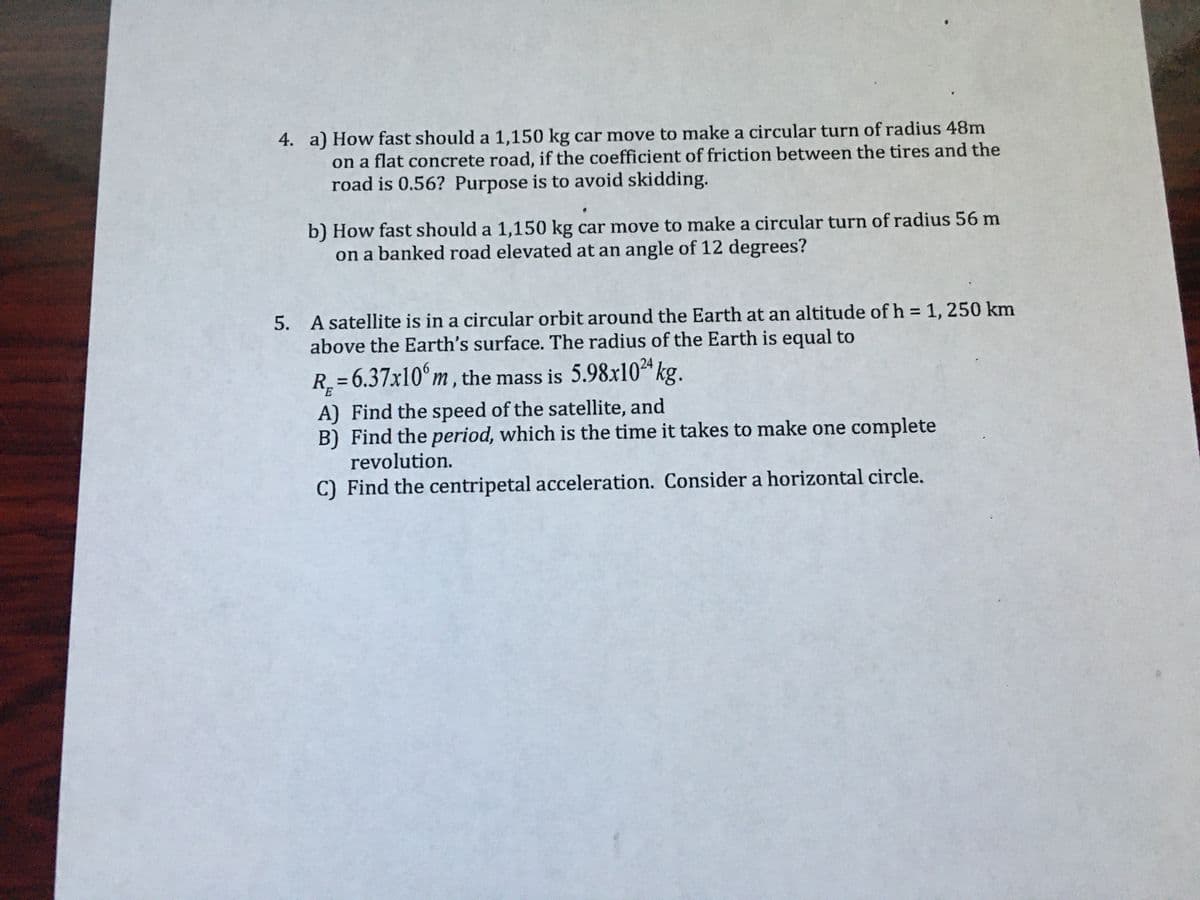4. a) How fast should a 1,150 kg car move to make a circular turn of radius 48m on a flat concrete road, if the coefficient of friction between the tires and the road is 0.56? Purpose is to avoid skidding. b) How fast should a 1,150 kg car move to make a circular turn of radius 56 m on a banked road elevated at an angle of 12 degrees?
4. a) How fast should a 1,150 kg car move to make a circular turn of radius 48m on a flat concrete road, if the coefficient of friction between the tires and the road is 0.56? Purpose is to avoid skidding. b) How fast should a 1,150 kg car move to make a circular turn of radius 56 m on a banked road elevated at an angle of 12 degrees?
Physics for Scientists and Engineers, Technology Update (No access codes included)
9th Edition
ISBN:9781305116399
Author:Raymond A. Serway, John W. Jewett
Publisher:Raymond A. Serway, John W. Jewett
Chapter13: Universal Gravitation
Section: Chapter Questions
Problem 13.7OQ
Related questions
Question
Can you please answer question 4 and all of the sub problems and show all of the steps to the solution

Transcribed Image Text:4. a) How fast should a 1,150 kg car move to make a circular turn of radius 48m
on a flat concrete road, if the coefficient of friction between the tires and the
road is 0.56? Purpose is to avoid skidding.
b) How fast should a 1,150 kg car move to make a circular turn of radius 56 m
on a banked road elevated at an angle of 12 degrees?
5. A satellite is in a circular orbit around the Earth at an altitude of h 1, 250 km
above the Earth's surface. The radius of the Earth is equal to
%3D
24
R = 6.37x10°m, the mass is 5.98x10 kg.
%3D
A) Find the speed of the satellite, and
B) Find the period, which is the time it takes to make one complete
revolution.
C) Find the centripetal acceleration. Consider a horizontal circle.
Expert Solution
This question has been solved!
Explore an expertly crafted, step-by-step solution for a thorough understanding of key concepts.
This is a popular solution!
Trending now
This is a popular solution!
Step by step
Solved in 3 steps with 4 images

Knowledge Booster
Learn more about
Need a deep-dive on the concept behind this application? Look no further. Learn more about this topic, physics and related others by exploring similar questions and additional content below.Recommended textbooks for you

Physics for Scientists and Engineers, Technology …
Physics
ISBN:
9781305116399
Author:
Raymond A. Serway, John W. Jewett
Publisher:
Cengage Learning

University Physics Volume 1
Physics
ISBN:
9781938168277
Author:
William Moebs, Samuel J. Ling, Jeff Sanny
Publisher:
OpenStax - Rice University

College Physics
Physics
ISBN:
9781938168000
Author:
Paul Peter Urone, Roger Hinrichs
Publisher:
OpenStax College

Physics for Scientists and Engineers, Technology …
Physics
ISBN:
9781305116399
Author:
Raymond A. Serway, John W. Jewett
Publisher:
Cengage Learning

University Physics Volume 1
Physics
ISBN:
9781938168277
Author:
William Moebs, Samuel J. Ling, Jeff Sanny
Publisher:
OpenStax - Rice University

College Physics
Physics
ISBN:
9781938168000
Author:
Paul Peter Urone, Roger Hinrichs
Publisher:
OpenStax College

Principles of Physics: A Calculus-Based Text
Physics
ISBN:
9781133104261
Author:
Raymond A. Serway, John W. Jewett
Publisher:
Cengage Learning

College Physics
Physics
ISBN:
9781305952300
Author:
Raymond A. Serway, Chris Vuille
Publisher:
Cengage Learning

Physics for Scientists and Engineers: Foundations…
Physics
ISBN:
9781133939146
Author:
Katz, Debora M.
Publisher:
Cengage Learning